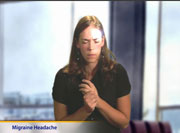
Migraine Headache
What is a migraine headache?
A migraine is a specific type of headache which happens from time to time. Migraine headaches may cause intense pain, nausea, or vision changes in children. Symptoms of migraines in children may be different from those in adults.
How does it occur?
The exact cause of migraines is not known. Migraine headaches tend to run in families, and often are triggered by specific things. Triggers of migraine headaches for some children include stress, missing a meal, a change in sleep pattern, bright or flickering lights, loud noises, and foods such as chocolate and nuts.
What are the symptoms?
Some children will feel the headache coming on and have a sensation of flashing lights, a feeling of tingling or numbness in a certain area, hear a buzzing or humming sound, or have other sensations. This is called an "aura."
Symptoms of migraine headaches may include:
- headache which is often on one side of the head only and often described as "throbbing" or "pulsing"
- stomach pain, nausea, or vomiting
- pale skin color
- numbness or tingling in the face, arm, hands, or feet
- a desire to avoid bright lights and loud noises.
How is it diagnosed?
Your child's healthcare provider will ask about the symptoms. Migraines often get better with sleep, which may be a helpful clue in the diagnosis. Children, especially younger children, often have difficulty explaining their symptoms. Your healthcare provider may ask you to keep a log or diary of when your child's headaches happen and anything that happened before the headache (such as eating certain foods or not getting enough sleep).
How is it treated?
An important part of treatment for migraines is avoiding the triggers for the headaches. Medicines such as acetaminophen or ibuprofen can help milder migraines. Check with your healthcare provider before you give any medicine that contains aspirin or salicylates to a child or teen. This includes medicines like baby aspirin, some cold medicines, and Pepto-Bismol. Children and teens who take aspirin are at risk for a serious illness called Reye's syndrome. Nonsteroidal anti-inflammatory medicines (NSAIDs) may cause stomach bleeding and other problems. These risks increase with age. Read the label and take as directed. Unless recommended by your healthcare provider, do not take for more than 10 days.
Other pain medicines may be prescribed by your healthcare provider if the headaches are severe or happen often. Medicines to keep your child from vomiting are also sometimes used.
How can I take care of my child?
When your child is having a migraine, put him or her in a quiet, dimly lit place to rest. Take note of the possible triggers of your child's headaches and help your child avoid these things in the future. Regular exercise and keeping a routine for eating and sleeping may help keep your child from having a lot of migraines.
How long will it last?
A migraine headache can last anywhere from 2 to 48 hours. Children with migraines often have 1 to 3 headaches each month, though this can vary from as few as one every few years to several times a week. After the headache goes away, some children may still feel tired or irritable.
More than half of children whose migraine headaches began before age 10 will improve. Many children do not have as many migraine attacks as they get older, even if their migraines began after age 10.
When should I call my child's healthcare provider?
Call immediately if your child has:
- severe pain which is not typical of their migraine headaches
- is not responsive or acts confused
- a seizure occurring with a migraine.
Call during office hours if your child has:
- a change in the character of his or her headaches, particularly a headache that awakens your child from sleep or occurs in the early morning
- behavioral changes or worsening school performance despite treatment of your child's headaches.
Last modified: 2011-06-29
Last reviewed: 2011-05-09

